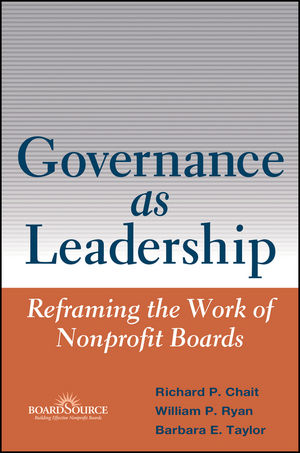Governance as Leadership: Reframing the Work of Nonprofit BoardsISBN: 978-0-471-68420-6
Hardcover
224 pages
October 2004
 |
||||||
About the Authors.
Preface.
Acknowledgments.
Chapter 1: First Principles.
Principle One: Nonprofit Managers Have Become Leaders.
Principle Two:Trustees Are Acting More Like Managers.
Principle Three:There Are Three Modes of Governance, All Created Equal.
Principle Four:Three Modes Are Better Than Two or One.
Chapter 2: Problem Boards or Board Problems?
Problems of Performance.
From Problems of Performance to Problems of Purpose.
Some Official Work Is Highly Episodic.
Some Official Work Is Intrinsically Unsatisfying.
Some Important Unofficial Work Is Undemanding.
Some Unofficial Work Is Rewarding but Discouraged.
The Challenge of Reform.
Chapter 3: Type I Governing: Fiduciary.
Type I Governing.
The Type I Mental Map.
The Type I Board.
Assessing the Problems.
Conclusion.
Chapter 4: Type II Governing: Strategic.
Nonprofits Enter the Marketplace.
Boards and Formal Strategy: A Type I Approach to Type II Work.
Strategic Disillusionment.
Strategic Thinking: Beyond a Type I Mindset.
Governing in Type II Mode.
The Evolution of Strategic Governance.
Processes and Structures for Type II Governing.
Implementing Strategy.
Why Not Just Types I and II?
Chapter 5: Type III: Generative Thinking.
The Power of Generative Thinking in Organizations.
Inside the Black Box of Generative Thinking.
Toward Generative Governing.
Leadership as Governance: Executives Displace Trustees.
Governance by Default: Trustees and Executives Disengage.
Governance by Fiat: Trustees Displace Executives.
Type III Governance: Trustees and Executives Collaborate.
Can Boards Do It?
Chapter 6: Type III: Generative Governing.
Using a Type III Mental Map of the Organization.
Recognizing Generative Landmarks.
Generative Landmarks.
Embedded Issues.
Spotting “Triple Helix” Situations.
Working at the Boundary.
Working at the Internal Boundary.
Working at the External Boundary.
Looking Back: The Future in the Rear-View Mirror.
Deliberating and Discussing Differently.
The Cardinal Rule: Suspend the Rules.
Promoting Robust Dialogue.
Mind the Mode.
The Payoffs.
Chapter 7: Working Capital That Makes Governance Work.
Intellectual Capital.
Reputational Capital.
Political Capital.
Social Capital.
Capitalizing on Trustees.
Chapter 8: Where to Next?
Is the Game Worth the Candle?
Diagnostics.
“Attractive Nuisances”.
A New Covenant.
Coming Full Circle.
References.
Index.



